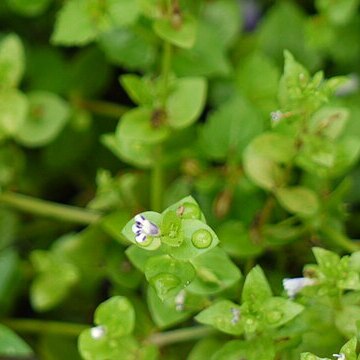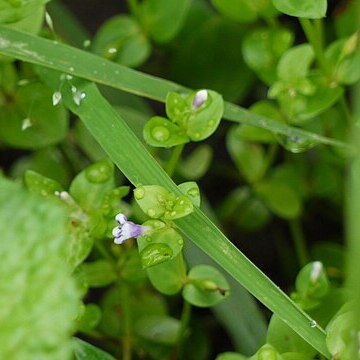Annual herb, semi-aquatic, up to 0.3 m high; stems simple to much branched, erect to creeping; glabrous. Leaves opposite, ± sessile, 10(-30) x 3 mm, shape variable, ± linear to ovate or acute, ± entire. Flowers mostly single, axillary. Pedicels 10(-15) mm long, often becoming reflexed. Calyx deeply divided. Corolla bilabiate, ± 7 mm long, upper lip ovate, lower lip longer, 3-lobed; white, pale blue, or mauve to violet with 2 yellow spots in throat. Stamens: 2 fertile, 2 staminodes. Flowering time Dec.-Apr.
Leaves sessile or shortly petiolate, 2–15(38) x 0.75–5(13) mm., opposite, ovate, ovate-lanceolate or elliptic, acute or obtuse, entire, or larger leaves occasionally minutely, shallowly dentate, l-3(5)-nerved.
Fertile stamens two, filaments 0.4–1 mm. long; staminodes two, 0.25–0.5(1) mm. long, slender, clavate at apex occasionally with short spur c. 0.75 mm. long, just below.
Erect, decumbent or ascending, annual herb, up to 150 mm tall, terrestrial. Stems leafy throughout. Calyx lobed almost to base. Flowers white or pale blue.
Diffuse annual to 20 cm. Leaves opposite, elliptic, somewhat glossy. Flowers in axils of upper leaves, white or pale blue. Capsules deflexed.
Erect, decumbent or ascending annual, 5–15(25) cm. tall, glabrous; stems usually diffusely branched, glabrous to rarely slightly pubescent.
Calyx (1.25)2–4 mm. long, glabrous, divided almost to base; lobes up to 0.5 mm. wide, lanceolate to linear-lanceolate, acute.
Capsule 1.5–4.5(6) x 1.25–1.75(2.5) mm., obovate-or cylindric-ellipsoid to nearly subglobose, usually longer than calyx.
Corolla white or pale blue, 4–7 mm. long, upper lip emarginate to shallowly bifid.
Pedicels (5)7–12 mm. long in flower, extending in fruit 9–17(25) mm. long.
Flowers axillary or in terminal racemes, slender pedicellate.
Petiole 0–2 mm. long.



